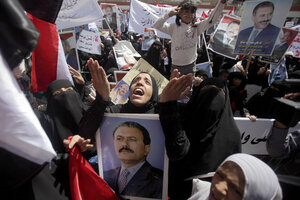In Yemen, a tentative road map for Saleh's departure
President Ali Abdullah Saleh has 'favorably received' a plan to lay out an exit strategy by year's end. But protesters have yet to come up with a plan for what's next.

Female supporters of Yemeni President Ali Abdullah Saleh chant slogans during a rally to support Saleh in Sanaa, Yemen, Thursday, March 3.
Muhammed Muheisen/AP
Sanaa, Yemen
Yemeni President Ali Abdullah Saleh has “favorably received” a road map that would delineate his departure and ensure a smooth transition of power, according to a government official.
The exact details of the plan, put forward by opposition leaders to defuse mounting tension in the streets, may be subject to change. But word that Mr. Saleh may agree on an exit strategy by the end of this year has done little to appease demonstrators, who insist that he step down immediately but have yet to formulate a cohesive plan should he do so.
“This is the people’s revolution, not the parties’,” says Sanaa University law student Tareq Abdul Aziz. “This is the political path, and we’ve been down it before. We don’t trust Saleh to keep his word and we will continue to protest until he is gone.”
Opposition bigger, but more diverse
Since the fall of former Egyptian president Hosni Mubarak injected new momentum into Yemen protests, opposition demonstrations in the capital, Sanaa, have grown from gatherings of hundreds of university students to crowds in the thousands that now include tribesmen, Islamists, opposition lawmakers, and city residents.
But as the number of demonstrators has increased, so too has the diversity of perspectives on what should happen if Saleh steps down – and the difficulty of working together to formulate a cohesive plan with broad backing.
“We’re not interested in discussion,” says Yahya al-Saha, a tribe member from Hamdan who along with dozens of fellow tribesmen has been camping in front of the university for days. “What we want now is democracy – real democracy and not the kind that is enforced by tanks and guns.”
Like Mr. Saha, the vast majority of opposition demonstrators are demanding transparent democracy. But there are also groups advocating everything from socialism to the restoration of the caliphate.
Earlier this week, the widely popular Sheikh Abdel Majid al-Zindani – designated a terrorist by the US – split with Saleh and called for the establishment of an Islamic state in a speech before tens of thousands of demonstrators.
'We need a plan'
In the event of a power vacuum, a transition period not exceeding 60 days is to be led by the vice president before presidential elections take place, according to the Yemeni constitution.
“People haven’t thought about what happens after the revolution," says parliament member Abdul Kareem al-Islamy, who along with 10 other representatives recently resigned from Saleh's General Peoples Congress party to join the opposition. "We’re thinking about it now. We need a plan.”
Indeed, the road from today’s demonstrations to a fully functioning democracy is unclear. Yemen is home to one of the region’s most active extremist groups, Al Qaeda in the Arabian Peninsula; a rebellion in the north led by Shiite Houthis; and an active separatist movement in the south.
“If there’s an opportunity for the south to secede, they may take it. The same for the Houthis. We don’t want a war. But not everyone in south wants secession, and if they can be involved in developing a new system they may not want to separate,” says Mr. Islamy.
Government loyalists cite the president’s ability to maintain order within the country as one of their primary reasons for support. Lacking a coherent plan, they say, the opposition threatens to drag the country into chaos, violence, and even civil war.
